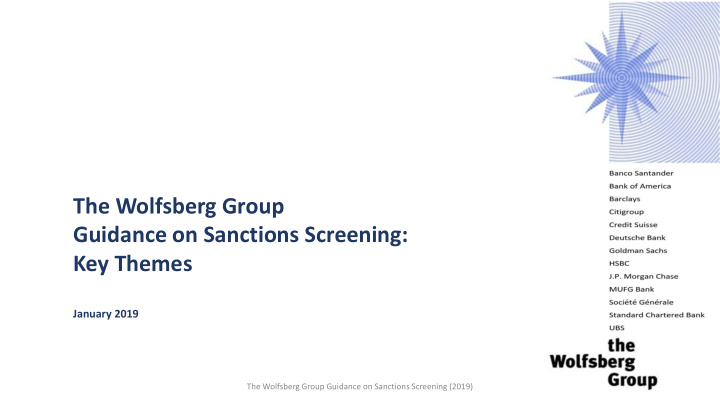



The Wolfsberg Group Guidance on Sanctions Screening: Key Themes January 2019 The Wolfsberg Group Guidance on Sanctions Screening (2019)
Purpose The Wolfsberg Guidance on Sanctions Screening aims to aid Financial Institutions (FIs) to understand and develop controls employed to detect, prevent and manage sanctions risks. The guidance sets out sanctions screening as a control, the fundamentals of which are derived from legal/regulatory requirements and expectations, as well as industry best practice. The guidance seeks to demonstrate the following: - where sanctions screening can be an effective part of a wider sanctions compliance programme - where it has limitations as a control - where a risk based approach may be appropriate, notwithstanding the strict liability nature of sanctions compliance Consideration has been given to topics such as what is meant by sanctions screening, looking at both reference/customer data and transaction screening; the timing of screening; technology and the use of automated systems; the criteria for alert investigation, as well as testing and quality assurance. It is not the Wolfsberg Group’s intention to suggest that all FIs should apply all elements in this guidance to the same level, rather it seeks to demonstrate where sanctions screening can be an effective part of a wider sanctions compliance programme. The Wolfsberg Group Guidance on Sanctions Screening (2019)
Contents • The guidance covers a number of areas that are most common to sanctions screening, but is not exhaustive. • The programmatic approach to sanctions screening is explored, including how to employ a risk based approach. • The generation of productive alerts and the use of technology is covered, as well as the importance of testing and validation of the results. • The guidance goes into some detail on the approaches to the two main elements of sanctions screening, namely, reference/customer data and transactions screening. • The use of regulatory and intelligence lists is explored, along with the management of weak aliases. • The guidance considers whether the screening of real-time transactions is necessary or appropriate within the risk appetite of the FI and, if not, whether the wider control framework mitigates the risk of not screening. • Finally, consideration is given to the importance of a historical review or ‘ lookback ’ . The Wolfsberg Group Guidance on Sanctions Screening (2019)
Observations In bringing together the guidance, the Wolfsberg Group noted a number of patterns: • There is a great deal of commonality in the design and execution of sanctions screening controls across the Wolfsberg member banks, which is encouraging and already suggests that core common practice exists in the industry. • There is a heightened increase in regulators’ mandate for the screening of domestic payments, which is more challenging than ever with innovation in technology and increased consumer expectation for instant settlement. • The increasing complexity of managing the risk of sectoral sanctions. • The importance that good quality data plays in the identification of strong quality alerts and sanctions risk. • A general interest from FIs and regulators in the opportunities created by an industry utility concept. The Wolfsberg Group Guidance on Sanctions Screening (2019)
Key Takeaways • The Wolfsberg Group believes FIs should seek to adopt a risk based approach to sanctions screening and to consider all aspects of a comprehensive sanctions screening control framework. • While sanctions screening is a primary control, it has its limitations and should be deployed as part of a wider effective Financial Crime Compliance (FCC) programme, to assist with the identification of sanctioned individuals and organisations. • It is important to have a clear strategy with respect to sanctions screening, to mitigate the risk of being exposed to sanctioned parties and countries. • The documentation of an FI’s risk appetite and approach to screening is imperative. • Technology remains a key enabler in the effectiveness of identifying financial crime risk through screening, making the process more efficient and on a real-time basis. • The FI should ensure that people involved in the end-to-end sanctions screening processes are robustly trained and supervised and that strong management information should be made available to assess the effectiveness of sanctions screening control. The Wolfsberg Group Guidance on Sanctions Screening (2019)
Recommend
More recommend